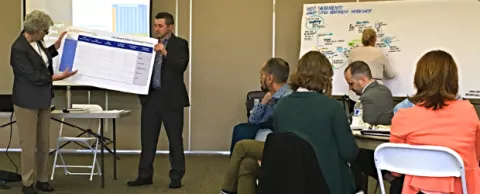
When we ask many cities what a smart cities project is, many answer with some form of technology. Sensors. Data analytics. Innovative tools. But over the course of our Readiness Workshop in West Sacramento, California, this week, participants embraced the idea that smart cities projects are ones that improve people’s lives. They make people feel safer. They help the disadvantaged get help sooner. They give more choices and more effective services. There is a lot of great work already underway in West Sacramento, but two things were especially inspiring about the work this week. First, the mayor and two council members actively participated throughout the Readiness Workshop. Second, the city is laser-focused on delivering actual value to residents. During a regular city council meeting, one council member asked how he could explain the smart cities work to his constituents. Without missing a beat, the mayor and a council member who participated described how people would feel positive differences in their lives even if they couldn’t see the technology that made that possible. That is what smart cities projects are all about. — Kevin Ebi West Sacramento is no stranger to technology projects. It has smart water meters. It was among the first to use a sentiment analysis tool to gauge public opinion. Its police department is using some predictive analytics. But those projects have been individual projects. The city used a Smart Cities Council Readiness Workshop to find bigger opportunities for more substantial improvement through a more holistic, systematic approach. “We want to extend our imagination around what’s possible in terms of problems that we’ve just come to accept or challenges that we just can’t seem to overcome or opportunities that are before us that we just haven’t seen,” said West Sacramento Mayor Christopher Cabaldon. Making a real difference every dayThrough the city’s efforts, it isn’t looking to make one quick splash. It’s looking to make a meaningful difference in people’s lives every day. Citizens approved a sales tax hike with some of the money earmarked to smarten projects. The city intends to make good on that investment. “The core of what we want to do with the smart cities work is in the base work of the organization, in the daily processes of the organization, and, frankly within the daily budget as well,” Cabaldon said. “(Citizens) don’t have to see the technology. They have to see the outcomes that we are creating in the community.” Fighting fears with dataDuring the Readiness Workshop, the city focused on four key areas: mobility, public safety, the built environment and communications. The city’s sentiment analysis reveals some work to be done in the area of public safety. For instance, the research shows that a number of residents are afraid to use certain parks. Among the more immediate action steps are suggestions to be more transparent with public safety data to help counter fears that may be exaggerated. The city also wants to do more to help the homeless, but has found data to be a barrier. A lot of the data the city wanted, it just couldn’t get — unavailable due to medical privacy laws. Instead of continuing to use that as an obstacle, participants discussed how they could make better use of data they can access. Public works logs, for instance, could help provide an almost real-time gauge of homeless encampments. The city may have other data that would help it intervene earlier with people who are about to become homeless. Additional action-planningIn the area of built environment, participants suggested the city work to use energy and other natural resources more efficiently. They suggest a long-term goal of using recycled water for landscaping and other uses, beginning with a review of the storm water program. They also suggested a short-term step of establishing water and energy benchmarks to use as a starting point for audits and other efficiency programs. Long-term, workshop participants suggested the city find ways to integrate all forms of transportation into a seamless, citizen-centric system. Early areas of suggested exploration include looking at bike- and ride-sharing programs, as well as developing a mobility action plan and better data collection to inform longer-term strategies. Finally, to provide connectivity to all residents, working groups suggested that the city conduct an assessment of it assets and partnerships that could be leveraged into providing additional wireless access points. Workshop Infographics





